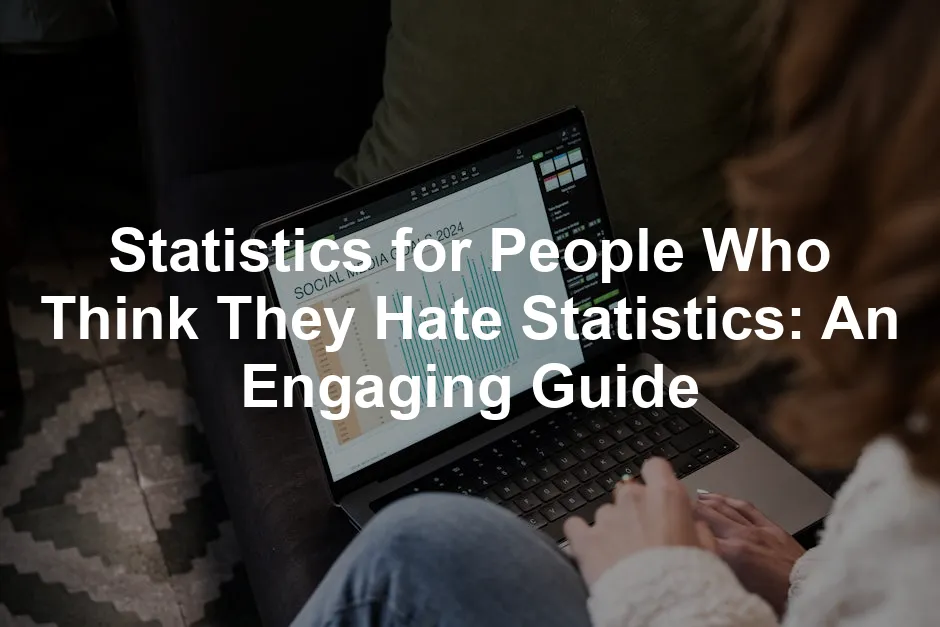Introduction
Statistics often feels like a foreign language. Many people hear “statistics” and immediately picture dense textbooks and complicated equations. No wonder it gets a bad rap! But statistics isn’t just for mathletes or data geeks. It’s a valuable tool in everyday life, helping us make informed decisions.
Understanding statistics can empower you. It’s not just for academics or researchers. From evaluating health reports to making savvy shopping choices, statistics plays a role. Imagine being able to interpret data with confidence. It changes how you engage with the world.
Enter Statistics for People Who (Think They) Hate Statistics by Neil J. Salkind. This book is like a warm hug for those intimidated by numbers. With humor and simplicity, Salkind breaks down complex concepts into digestible bites. He makes statistics feel less like a chore and more like a fun puzzle to solve. Yes, you read that right—statistics can actually be enjoyable!
So, if you’ve ever squirmed at the thought of statistics, fear not! This guide is here to invite you into the world of numbers. We’ll tackle the basics, highlight common misconceptions, and show you how statistics can be your best friend. Buckle up, because we’re about to transform your view of statistics from dread to delight!

Understanding the Basics of Statistics
What Are Statistics?
Statistics is the science of data. It involves collecting, analyzing, and interpreting information. Think of it as the art of making sense of numbers. Statistics helps us understand patterns and trends in data. From weather forecasts to election polls, statistics is everywhere.
Why is this important? Because statistics allows us to make informed choices. For instance, when you see a statistic about health risks, it can guide your decisions. Want to lose weight? Charts and data can help track your progress. Statistics also come into play in business. Companies rely on data for marketing, sales forecasts, and customer satisfaction.
In essence, statistics helps us navigate a world overflowing with information. It equips us to sift through noise and focus on what matters. By grasping the basics, you can become a savvy consumer of information. No more blindly accepting numbers—understanding statistics gives you the power to question and analyze.
So, let’s embrace statistics. It’s not just for scientists or mathematicians. It’s a tool for everyone. And with resources like Salkind’s book, you’ll see that learning statistics can be a fun and enlightening experience!

Types of Statistics
Descriptive Statistics
Descriptive statistics summarize data. They provide a snapshot of what’s happening within a dataset. Let’s break it down into three key measures: mean, median, and mode. For a deeper understanding of descriptive statistics, you can check out this comprehensive guide.
Understanding descriptive statistics is essential for analyzing data effectively. Learn more about descriptive statistics in a manufacturing plant.
– Mean: This is the average. Add all values, then divide by the number of items. For instance, if your test scores are 70, 80, and 90, the mean is (70+80+90)/3, which equals 80.
– Median: This is the middle value. Arrange your numbers in order and find the center. If we have scores of 70, 80, and 90, the median is 80. If scores are 70, 80, 90, and 100, the median is (80+90)/2, which is 85. For insights on median salaries in Poland, refer to this comprehensive insights.
The median is a critical measure of central tendency, especially in salary analysis. Explore median salary insights in Poland for 2024.
– Mode: This is the most frequently occurring number. If your scores are 70, 80, 80, and 90, the mode is 80 since it appears twice.
Now, let’s sprinkle in some variability. Variability shows how spread out the data is. A high variability means scores vary greatly, while low variability means they cluster closely. Imagine a classroom: if everyone scores around 85, the variability is low. But if one student scores 50 while others score 90, the variability is high.
Inferential Statistics
Inferential statistics lets us make predictions or inferences about a larger population based on a sample. Two big players here are hypothesis testing and confidence intervals. To understand the challenges in inferential statistics, refer to this article on the problems with inferential statistics.
Inferential statistics can be tricky, but understanding its problems is crucial. Read more about the issues with inferential statistics.
– Hypothesis Testing: This is like playing detective. You start with a hypothesis—an educated guess—and test it. For example, you might hypothesize that students who study with music score higher. You gather data, run tests, and see if the evidence supports your claim.
– Confidence Intervals: This provides a range of values that likely includes a population parameter. For instance, if a survey shows that 60% of people prefer chocolate ice cream, but with a 95% confidence interval of 55%-65%, we can say we’re pretty sure the true preference lies within that range.

Why People Dislike Statistics
Many people cringe at the thought of statistics. Why? Misconceptions and fears loom large. A common belief is that statistics is all about complicated formulas. Spoiler alert: it doesn’t have to be!
Some folks think statistics is dry and boring. But wait! It’s not all numbers and graphs. Statistics helps us understand real-world situations, from sports analytics to health data.
Anecdotes from students reveal their fears. One student shared, “I thought statistics was just math on steroids!” Another exclaimed, “I feared being lost in a sea of formulas!” It’s clear that anxiety surrounds the subject.
Statistics can seem daunting, but it’s about perspective. With a sprinkle of humor and engaging examples, it can transform from a horror show into a fun learning endeavor. Embrace the quirks of statistics, and you might just find it’s not so scary after all!

Interactive Learning Approaches
Statistics can feel like a puzzle, but tools like SPSS can be your best friends. SPSS, or Statistical Package for the Social Sciences, simplifies data analysis. It’s like having a personal assistant for stats! You can input data, run analyses, and visualize results without breaking a sweat. Many students find that using SPSS transforms the intimidating into the manageable. For troubleshooting SPSS on macOS, refer to this comprehensive guide.
SPSS is a valuable tool for data analysis in statistics. Learn how to troubleshoot SPSS on macOS.
But let’s not stop there. Real-world applications make statistics come alive. Imagine learning about averages by analyzing your favorite sports team’s performance stats. Or how about studying population data to understand trends in your community? When you see statistics in action, it becomes relatable and engaging. Connecting concepts to practical examples helps solidify your understanding. It’s all about making statistics relevant to your life!
For those looking to dive deeper into data science, consider picking up Data Science for Business: What You Need to Know about Data Mining and Data-Analytic Thinking by Foster Provost. This book is a great companion for understanding how data can drive business decisions and strategies.

The Role of Practice
Just like mastering a musical instrument, practice is key in statistics. You can’t expect to ace a subject without putting in the effort. Regular practice helps reinforce concepts and builds confidence. The more you practice, the less daunting it becomes.
So, how can you practice effectively? One excellent resource is StatQuest with Josh Starmer: Statistics for Data Science. It’s packed with exercises designed to boost your statistical skills. Work through the problems, and don’t shy away from the challenging ones. They’re where the magic happens!
Consider forming a study group, too. Discussing problems with peers can provide new insights and make learning fun. Plus, teaching others is one of the best ways to solidify your knowledge. So grab your favorite snack, gather some friends, and tackle those statistics exercises together!

Correlation and Regression
Correlation measures the relationship between two variables. It tells us how one variable changes in relation to another. For instance, if ice cream sales rise, do we see a rise in beachgoers? Spoiler alert: yes! This is correlation in action. It doesn’t prove one causes the other, but it shows a connection worth noting.
Understanding correlation is key in data analysis. It helps identify patterns. Higher correlation values (closer to +1 or -1) imply stronger relationships. A value near 0 suggests little to no relationship. So, next time you hear about a correlation, think of it as a helpful hint, not a direct cause!
Now, let’s talk regression analysis. This is a step further. Regression helps predict outcomes based on relationships. Imagine you’re a real estate agent. You want to predict home prices based on square footage. By using regression analysis, you can create a model. This model estimates price based on size. It’s like having a crystal ball, but with numbers!
For those delving deeper into the world of predictive modeling, consider The Elements of Statistical Learning: Data Mining, Inference, and Prediction by Trevor Hastie. This book provides a comprehensive overview of statistical learning techniques, giving you the tools to make informed predictions.

Inferential Statistics Demystified
Hypothesis testing sounds fancy, but it’s simpler than it seems. Essentially, it’s making an educated guess. You start with a hypothesis, like “students who study at night score higher.” Then, you collect data and analyze it. If the data supports your idea, great! If not, back to the drawing board.
P-values come into play next. A p-value tells you the likelihood that your results happened by chance. A small p-value (usually less than 0.05) suggests a strong case for your hypothesis. Confidence intervals add another layer. They provide a range where you expect the true value lies. If a survey shows 60% of people prefer chocolate, a 95% confidence interval might be 55% to 65%. This means you can be quite sure the true preference is within that range.
If you want to dig deeper into hypothesis testing and p-values, check out How to Lie with Statistics by Darrell Huff. It’s a classic that reveals how statistics can be misused, helping you become a more critical thinker.

Non-parametric Statistics
Non-parametric tests are your go-to when data doesn’t fit traditional assumptions. If your data is skewed or doesn’t follow a normal distribution, these tests shine. They’re flexible and can handle various types of data.
When do you use them? Imagine you’re comparing two groups, but their sizes vary. A non-parametric test, like the Mann-Whitney U test, is perfect for this situation. It assesses differences without requiring a normal distribution.
For example, let’s say you want to compare test scores from two classes. If one class has 30 students and the other only 15, a non-parametric test gives you a fair comparison. It’s like ensuring everyone gets a fair shot at the prize, regardless of class size.
In essence, non-parametric statistics provide valuable insights when the usual methods fall short. They make sure that every piece of data has its moment in the spotlight!
Statistics in Various Professions
Statistics isn’t just for mathematicians or researchers. It’s a vital tool across numerous professions. Let’s take a look at a few fields where statistics reign supreme.
In healthcare, statistics are the backbone of patient care and medical research. Doctors use statistical data to determine treatment effectiveness. For example, clinical trials rely on statistical analysis to evaluate new medications. By understanding the success rates and potential side effects, healthcare providers can make informed decisions. A recent study showed that a new drug reduced symptoms in 75% of patients, a statistic that can change treatment protocols.
Marketing is another field that thrives on statistics. Marketers analyze consumer behavior and preferences through data. They track engagement rates, conversion rates, and customer demographics. For instance, a marketing team might discover that a specific age group responds better to certain ads. Armed with this information, they can tailor their campaigns to target that demographic effectively. The right statistics can make or break a marketing strategy!
Social sciences also heavily depend on statistics. Researchers use statistical methods to analyze survey data and draw conclusions about societal trends. Imagine a sociologist studying the impact of social media on youth behavior. By collecting and analyzing data, they can identify patterns and make evidence-based recommendations. If research shows that 60% of teens experience negative effects from social media, that’s a statistic that policymakers can’t ignore!
For those interested in the social sciences, Statistical Methods for the Social Sciences by Alan Agresti is a great read. It provides essential tools for understanding statistical analysis in social research.
These examples illustrate that statistics are everywhere. Understanding how to interpret and apply statistical data can significantly enhance decision-making in various professions. So, the next time you think of statistics as boring, remember how crucial they are in shaping our world.

Please let us know what you think about our content by leaving a comment down below!
Thank you for reading till here 🙂
All images from Pexels




